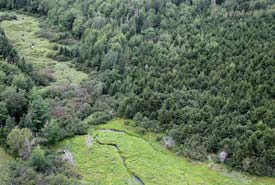Wabanaki (Acadian) forest

Docherty's Brook, NS (Photo by Mike Dembeck)
Wabanaki (Acadian) forest is the predominant forest type in the Maritimes and is confined to these provinces (Nova Scotia, Prince Edward Island and New Brunswick). It boasts a rich diversity of more than 30 species of native trees. This mixed wood forest ecosystem provides habitat for wide-ranging mammals, such as Canada lynx, and supports breeding bird populations. Less than one per cent of original old growth Wabanaki (Acadian) forest remains today, making it one of the rarest forest types in North America.
What trees are found here?
Wabanaki (Acadian) forests feature a number of coniferous and deciduous trees, including:
- balsam fir
- eastern hemlock
- red spruce
- sugar maple
- yellow birch
What is NCC doing to help protect this habitat?
The Wabanaki (Acadian) forest is the focus of much of the Nature Conservancy of Canada’s (NCC’s) work in New Brunswick, Nova Scotia and PEI, including Riverside-Alberta project in the Bay of Fundy, Upper Ohio project and Parr Lake project in southwestern Nova Scotia.




